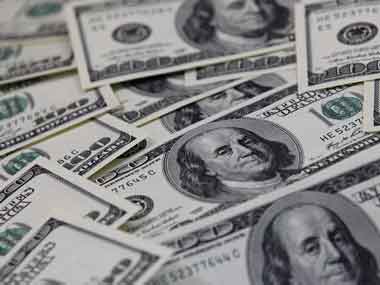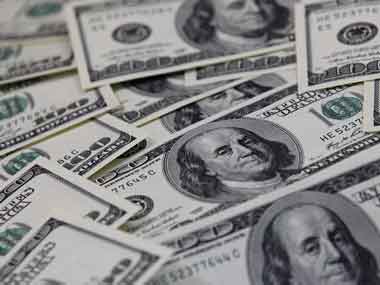India should thank Narendra Modi and crude oil for its all-time high foreign exchange reserves at $322 billion logged in the last week - the prime minister for creating a positive wave that has drawn higher foreign institutional investments and crude for the free fall in its prices, thus leading to a lower dollar outgo. In just a week, reserves swelled by $2.66 billion, helping the forex kitty cross the $320 billion mark for the first time since September 2011. Besides the first two factors, another factor that contributed to the rise is the central bank’s dollar buying spree in order to arrest a sharp appreciation in the rupee. [caption id=“attachment_2023049” align=“alignleft” width=“380”]
 Growing foreign exchange reserves. Reuters[/caption] Foreign brokerage Bank of America Merrill Lynch expects India’s reserves to grow enough to cover ten months of import bill by March 2016, which currently stands at about eight months. With the country managing to amass so much of dollar reserves, should the RBI now rethink its hesitance to use part of it to develop infrastructure, where, estimates say, there is a requirement of Rs 1 lakh crore by 2017 to build roads, ports and power units? The theory of economic prudence would say no. Infrastructure indeed is a cash-starved sector. Despite the involvement of the private companies in key projects, majority of the funding for the infrastructure segment has so far been done by commercial banks. Until November end, banks have a loan outstanding of Rs 8.8 lakh crore to infrastructure projects. The government’s ability to shell out money to ramp up infrastructure development is limited given its focus on fiscal discipline. The Modi wave, which has indeed improved the confidence of global and domestic investors in the India story, hasn’t yet succeeded in converting the positive sentiment into real investments on the ground. That gives room for the debate on whether forex reserves should be used to fund India’s infra growth. The debate, for sure, is a decade old. During the UPA regime, when P Chidambaram was the finance minister, the government had initiated discussions with the RBI to use some part of the reserves for this purpose. But the plan didn’t take off since the central bank has never been keen on the idea. The only possible instance, when the reserves have been partly deployed for infra funding, was when a limited window was created through setting up of an overseas subsidiary of IIFC (UK) Ltd in April 2008. Under that scheme, the RBI had committed to invest an aggregate $5 billion in tranches in fully government guaranteed foreign currency denominated bonds issued by the overseas special purpose vehicle of IIFCL. The funds were to be utilised for on-lending to the Indian companies implementing infrastructure projects in India or to co-finance the external commercial borrowings (ECBs) of such projects for capital expenditure outside India without creating any monetary impact. But beyond that, the RBI has been pretty conservative in opening up the reserves kitty. Experts have all along argued that using forex reserves is a dangerous idea since the reserves are meant to act as a cushion to be deployed in bad times. “Using forex reserves for infra funding isn’t a good idea. Forex reserves are like insurance, which the RBI is holding for a rainy day,” said DK Joshi, chief economist at rating agency, Crisil, a subsidiary of Standard and Poor’s. “India’s infrastructure problems should be sorted out by resolving the basic, structural problems. That would take care of funding issue,” said Joshi. The solution to resolve India’s infrastructure conundrum lies in resolving the structural bottlenecks, such as ensuring fuel linkages and making the clearance process faster. Once this happens, private investments would automatically begin to flow into infrastructure development, experts argue. The caution is warranted since the global financial markets are still not recovered into full health, says Joshi of Crisil. In the absence of a sustainable recovery in global economies, the possibility of a capital flight cannot be ruled out in the event of a crisis situation, Joshi said. “The problem is with the business model of infrastructure projects. It is risky to use the reserves for infrastructure development unless the problem is sorted out,” said Abizer Diwanji, national head of financial services at EY India. It would be perhaps better to begin repairing the structural issues plaguing infrastructure segment and encourage more domestic investments to these projects in the initial stage. Once the stalled projects are up and running, foreign investments will naturally flow in. Eyeing the dollar reserves to resolve India’s capital conundrum may not be a good idea.
Growing foreign exchange reserves. Reuters[/caption] Foreign brokerage Bank of America Merrill Lynch expects India’s reserves to grow enough to cover ten months of import bill by March 2016, which currently stands at about eight months. With the country managing to amass so much of dollar reserves, should the RBI now rethink its hesitance to use part of it to develop infrastructure, where, estimates say, there is a requirement of Rs 1 lakh crore by 2017 to build roads, ports and power units? The theory of economic prudence would say no. Infrastructure indeed is a cash-starved sector. Despite the involvement of the private companies in key projects, majority of the funding for the infrastructure segment has so far been done by commercial banks. Until November end, banks have a loan outstanding of Rs 8.8 lakh crore to infrastructure projects. The government’s ability to shell out money to ramp up infrastructure development is limited given its focus on fiscal discipline. The Modi wave, which has indeed improved the confidence of global and domestic investors in the India story, hasn’t yet succeeded in converting the positive sentiment into real investments on the ground. That gives room for the debate on whether forex reserves should be used to fund India’s infra growth. The debate, for sure, is a decade old. During the UPA regime, when P Chidambaram was the finance minister, the government had initiated discussions with the RBI to use some part of the reserves for this purpose. But the plan didn’t take off since the central bank has never been keen on the idea. The only possible instance, when the reserves have been partly deployed for infra funding, was when a limited window was created through setting up of an overseas subsidiary of IIFC (UK) Ltd in April 2008. Under that scheme, the RBI had committed to invest an aggregate $5 billion in tranches in fully government guaranteed foreign currency denominated bonds issued by the overseas special purpose vehicle of IIFCL. The funds were to be utilised for on-lending to the Indian companies implementing infrastructure projects in India or to co-finance the external commercial borrowings (ECBs) of such projects for capital expenditure outside India without creating any monetary impact. But beyond that, the RBI has been pretty conservative in opening up the reserves kitty. Experts have all along argued that using forex reserves is a dangerous idea since the reserves are meant to act as a cushion to be deployed in bad times. “Using forex reserves for infra funding isn’t a good idea. Forex reserves are like insurance, which the RBI is holding for a rainy day,” said DK Joshi, chief economist at rating agency, Crisil, a subsidiary of Standard and Poor’s. “India’s infrastructure problems should be sorted out by resolving the basic, structural problems. That would take care of funding issue,” said Joshi. The solution to resolve India’s infrastructure conundrum lies in resolving the structural bottlenecks, such as ensuring fuel linkages and making the clearance process faster. Once this happens, private investments would automatically begin to flow into infrastructure development, experts argue. The caution is warranted since the global financial markets are still not recovered into full health, says Joshi of Crisil. In the absence of a sustainable recovery in global economies, the possibility of a capital flight cannot be ruled out in the event of a crisis situation, Joshi said. “The problem is with the business model of infrastructure projects. It is risky to use the reserves for infrastructure development unless the problem is sorted out,” said Abizer Diwanji, national head of financial services at EY India. It would be perhaps better to begin repairing the structural issues plaguing infrastructure segment and encourage more domestic investments to these projects in the initial stage. Once the stalled projects are up and running, foreign investments will naturally flow in. Eyeing the dollar reserves to resolve India’s capital conundrum may not be a good idea.
Forex kitty swells to hit a record but still RBI shouldn't use it to fund infra
Dinesh Unnikrishnan
• January 24, 2015, 21:23:11 IST
Once the stalled projects are up and running, foreign investments will naturally flow in.
Advertisement
)
End of Article